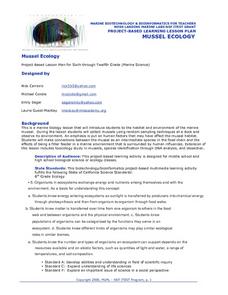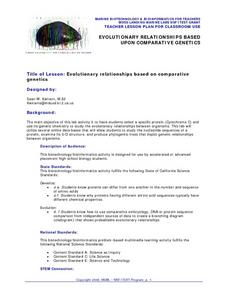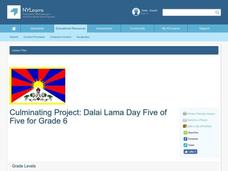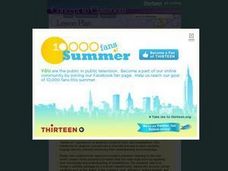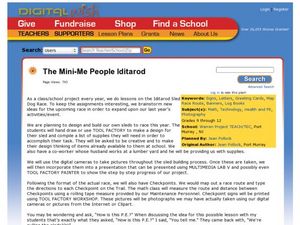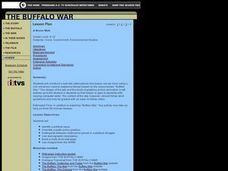Curated OER
Mussel Ecology
Students are introduced to the marine environment of the mussel. The emphasis of the lesson is upon what human factors are present to influence the environment in positive and negative ways. They brainstorm in groups in order to conduct...
Curated OER
Scientists Write!
Students use a journal to record observations. They make notes about what research may be needed to answer questions that have come up in the field and sketch or make connections in the curriculum. They research bioinformatics and...
Curated OER
Evolutionary Relationships Based Upon Comparative Genetics
Students investigate the protein cytochrome c in an attempt to use its genetic chemistry to study possible evolutionary relationships between organisms. The lesson integrates technology with the use computers to perform DNA analysis.
Curated OER
Catalase: A Bioinformatics Case Study
Students investigate the physical structure of a protein by using a computer simulation tool. They record its primary amino acid structure while viewing it in three dimensions for a better visual recognition. There is also a comparison...
Curated OER
Patterns Everywhere!
Learners recognize and demonstrate the patterning of numbers and objects in our environment. They create a pattern using geometric shapes and find a missing number in a sequence.
Curated OER
Geometric Figures and Applications
High schoolers study geometric figures. They use graph paper or Geometer's Sketchpad to construct and decorate geometric shapes, and also create a 3-D polygon using construction paper and a given template.
Curated OER
Publishing a Newspaper about Biomes
Young journalists create newspapers of individual biomes after researching their biomes. This instructional activity can be completed in three phases and concludes with each person publishing their individual newspaper pages.
Curated OER
Introduction to Victorian Valentines
Students explore the history of Valentine's Day and how paper valentines became a tradition in Victorian times. Using a photo organizer, they select photos using tags. They use a software program to create a special image for their...
Curated OER
Haiku Movies
Pupils create a movie to illustrate an original haiku poem in this upper-elementary school, Language Arts lesson utilizing technology. The lesson meets state standards for Language Arts and includes a materials list and possible lesson...
Curated OER
Dalai Lama
Sixth graders use skills and knowledge that they gained from their Tibet unit to formulate a final product of their Tibet journey. This study covers topics such as Tibet's geographical location, religious beliefs, customs, dress, and way...
Curated OER
Lesson 2: Measurement Tools
Elementary schoolers examine the uses of rulers, scales, and measuring cups. They determine the criteria for the use of each tool and visit different areas of school to find items that can be measured with these tools. Everyone takes...
Curated OER
"Inside Parts of a Computer Project" WebQuest
Middle schoolers participate in a role play situation in which they act as a private investigator to determine the parts found inside a computer. They complete web based research. They create a slide show that describes inner workings of...
Curated OER
Building Understanding of Rate of Change/Slopes Using Alice
Young scholars explore slope as a rate of change. In this eighth grade mathematics lesson, students investigate real-world problems to determine rate of change and transform it into a linear representation, thus determining slope. Young...
Curated OER
Volunteering From Camp
Eleventh graders examine the imprisonment of Americans during WWII. In this American History lesson, 11th graders participate in webquest. Students analyze various resources on the internet and discuss self sacrifice and their own...
Curated OER
Climate Change
Students compare weather data and draw conclusions. In this climate change lesson plan, students determine whether data collected over a period of ninety years shows a warming trend.
Curated OER
Animal Slideshow
Second graders view animal fact sheets, and make a slide about an animal. In this animal classification lesson, 2nd graders list facts that help classify the animal. Students use Microsoft paint and color their animal. Students use the...
Curated OER
Sound Vibrations
Young scholars play their own straw kazoos and understand that vibrations are responsible for the sounds we hear. Additionally, they learn that sound vibrations can travel through different mediums. Students experience vibrations ...
Curated OER
Career Exploration
Students complete a unit about career choices. They conduct research on a selected career that interests them, conduct an interview, explore various websites, create a five-page HyperStudio stack, and write ten checks that relate to...
Curated OER
Why is this lesson constructivist?
Students formulate a definition of tessellations by comparing and contrasting different patterns and shapes of real objects. They discuss the relatioship between shapes and patterns as well as their function in the real world. Students...
Curated OER
Endangered Animals in Texas
Young scholars research endangered animal in the library and on the Internet for information on its description, habitat, forces causing its decline, and programs to help it; students create slide show about the animal that contains a...
Curated OER
Publishing a Magazine
Students work collaboratively to create, edit, and publish their own student magazine. The lesson suggests the use of iPhoto, a word processor, iPages, and digital cameras for the creative process.
Curated OER
The Mini-Me People Iditarod
Learners participate in the "Iditarod" sled race. In this Iditarod lesson, students build their own sleds and pull their classmates to checkpoints. They use mushing terms and get timed to see how fast they go.
Curated OER
Celebrating Ancestors
Learners participate in a "hands-on" activity, to explain that African masks were and are more than aesthetic artifacts, they are functional implements of the many cultures of the African continent.
Curated OER
A Bison Web
High schoolers view a documentary on the treatment of the buffalo. In groups, they create a website using ideas and solutions they developed. They must include graphics or animation and a multi-level webpage. They share their pages...


